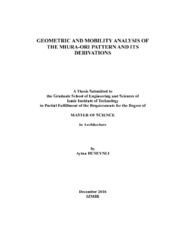Please use this identifier to cite or link to this item:
https://hdl.handle.net/11147/5708| Title: | Geometric and Mobility Analysis of the Miura-Ori Pattern and Derivations | Other Titles: | Miura-ori ve Türevlerinin Geometrik ve Serbestlik Derecesi Analizi | Authors: | Hüseynli, Ayten | Advisors: | Korkmaz, Koray | Keywords: | Rigid origami Miura-Ori Spherical mechanisms Mobility |
Publisher: | Izmir Institute of Technology | Source: | Hüseynli, A. (2016). Geometric and mobility analysis of the miura-ori pattern and derivations. Unpublished master's thesis, İzmir Institute of Technology, İzmir, Turkey | Abstract: | Origami is a Japanese art of folding paper. Recently it has started to be used in aerospace applications such as deployable masts, satellite antennas, and in architectural applications such as emergency shelters, temporary shelters, portable exhibition stands. Deployable plate structures based origami art are attractive to both architects and engineers because of their structural and spatial qualities. They have special geometries according to the rigid origami patterns. The Miura-Ori is a rigid origami pattern that is formed from a tessellated arrangement of a single repeated unit consists of four quadrangle plates. It has fully folded and fully deployed configurations. This research investigates geometric and mobility aspects of Miura-Ori pattern with its derivations and explore the possibilities of constructing a deployable plate structure using the same pattern. The first part of the research investigates geometry of the Miura patterns. The aim is to generate derivations by changing the input parameters. Small scale physical models are built to verify the geometric design guidelines. Miura unit consisted of four plates and four joints is a single degree of freedom spherical mechanism. The second part of the research is concentrated on mobility analysis. The aim is to develop a method for removing excessive plates and joints without changing the mobility. The established equations assist us to determine nth term of the excessive plates and joints. A Method of Double Arrangement (MoDA) is developed in order to determine the placement of excessive plates. Finally, a deployable plate structure based on Miura-Ori pattern is proposed for an architectural application. However, the plates cause obstruction of the sky, thereby affecting sunlight and daylight availability inside the building. Thus, some excessive plates are reduced according to the proposed method. The final form of the structure lets to get more energy from the sun to provide heating and lighting. Origami bir Japon kağıt katlama sanatıdır. Son yıllarda açılıp-kapanan direkler, uydu antenleri gibi uzaya dair uygulamalarda, acil ve geçici sığınaklar, taşınabilir sergi stantları gibi mimari alanlarda uygulanmaya başlamıştır. Origamiden esinlenilen açılıp kapanabilen plak strüktürler yapısal ve mekansal özellikleri nedeniyle mimar ve mühendisler tarafından ilgi çekmektedir. Bu strüktürlerin rijit origami desenlerinden kaynaklanan özel geometrileri vardır. Miura-Ori rijit origami dört plakadan oluşan bir birimin tekrarlanmasından oluşur. Tam kapanıp açılabilme özelliğine sahiptir. Bu tez Miura-Ori ve türevlerini geometrisi ve serbestlik derecesi açısından inceleyerek bir hareketli plak strüktür oluşturma olasılıklarını incelemektedir. Tezin ilk kısmı Miura-Ori rijit origaminin geometrisini önceden belirlenmiş parametreleri ile hesaplamalı incelemektedir. Amaç, istenilen formlara ulaşmak için geometrik kısıtlamaları türetmektir. Küçük ölçekli fiziksel modeller, geometrik tasarım yönergelerini doğrulamak için oluşturulmuştur. Miura birimi dört adet sert plakadan ve dört adet döner mafsaldan oluşan tek serbestlik dereceli bir küresel mekanizmadır. Tezin ikinci kısmı serbestlik derecesi analizi üzerine yoğunlaşmıştır. Amaç tek serbestlik dereceli olma durumunu değiştirmeden elimine edilecebilecek plaka ve mafsalları belirlemek için bir yöntem geliştirmektir. Son olarak, mimari bir uygulama için Miura-Ori modeline dayanan hareketli bir plak strüktür önerilmiştir. Ancak mimari uygulama düşünüldüğünde plakalar gökyüzünü kapatarak binanın içinde güneş ışığı ve gün ışığının kullanılabilirliğini etkiler. Bu sebeple bazı plakalar önerilen metoda uygun olarak eksiltilmiştir. Yapının nihai şekli, ısıtma ve aydınlatma sağlamak için güneşten daha fazla enerji almamızı sağlayacaktır. Çözümleri göstermek için fiziksel bir model de yapılmıştır. |
Description: | xii, 101 leaves Thesis (Master)--İzmir Institute of Technology, Architecture, İzmir, 2016 Includes bibliographical references (leaves: 98-101) Text in English; Abstract: Turkish and English |
URI: | http://hdl.handle.net/11147/5708 |
| Appears in Collections: | Master Degree / Yüksek Lisans Tezleri |
Files in This Item:
| File | Description | Size | Format | |
|---|---|---|---|---|
| T001537.pdf | MasterThesis | 6.13 MB | Adobe PDF |  View/Open |
CORE Recommender
Page view(s)
444
checked on Jun 10, 2025
Download(s)
1,360
checked on Jun 10, 2025
Google ScholarTM
Check
Items in GCRIS Repository are protected by copyright, with all rights reserved, unless otherwise indicated.